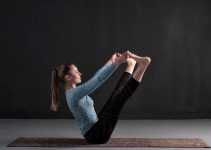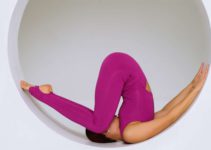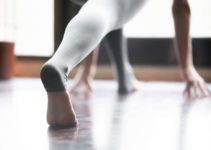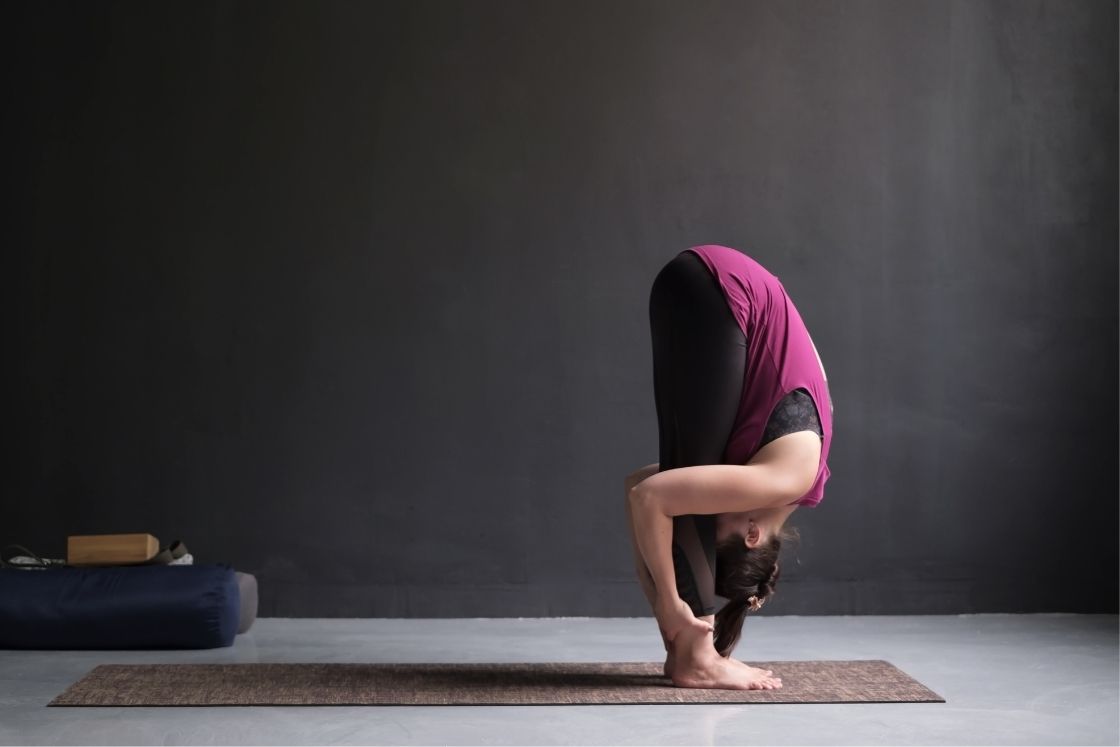
Uttanasana is a forward fold yoga pose in which the trunk is bent forward & down to the feet from the hip joint. It’s popularly known as Standing forward bend pose, Standing head to knee pose & Intense stretch pose.
Uttanasana targets stretching the muscles of the legs including hamstrings, calves, and quad. Along with this, it stretches the hips and entire sheath of muscles and connective tissue of the lower body.
Uttanasana Meaning
The term ‘uttanasna’ has three Sanskrit words, ‘ut’ means ‘intense, ‘tan’ is ‘to stretch’, and ‘asana’ refers to ‘pose.’ This makes the significance of asana clearer, as it is all about the intense stretching of the spine.
Uttanasana releases any tension or tightness present in the muscles and tissues around the spine. It increases the flexibility of the spine and makes it strong. The standing forward bend pressurizes the abdomen and stimulates the abdominal muscles.
Standing forward bend pose can also be considered as inverted posture as here the head comes below the heart and belly touches the thighs. It allows the blood to rush to the head and increases the flow of oxygen to the cells. This leaves a rejuvenating effect on the body.
Uttanasana Practice Guide

Before practicing Uttanasana, go through following points;
Contraindications
- Do not practice uttanasana in severe migraine. The pose involves a sudden flow of fresh blood to the head. It might leave the practitioner with a heavy head.
- Avoid practicing it with complete forward bend if you are pregnant or menstruating. Instead try its variation, i.e. Ardha uttanasana by keeping the spine parallel to the floor and hands on the wall.
- In case of a high blood pressure stay in the pose for an extended period only if the breath is not straining.
- Avoid doing it with full forward bend if you’ve had a back injury.
- Do not perform the pose if you have sciatica.
Preparatory poses
- Seated Forward Bend Pose (Paschimottanasna)
- Upward/half Forward Fold (Ardha uttanasana)
- Downward Dog Pose (Adho mukha svanasana)
- Head-to-Knee Pose (Janu Sirsasana)
- Reclining Hand-to-Big-Toe Pose (Supta Padangusthasana)
Uttanasana Steps
- Stand in mountain pose and bring your hands to your waist.
- Be there and take a few deep breaths.
- Exhale bending forward from the hips pushing them back and keeping the spine straight.
- Keep bending until the head and neck hangs down.
- Place your hands to your feet and keep breathing.
- Try to bend further and bring your palms to the back of the ankles.
- Touch your forehead to your knees, relax, and keep your eyes closed.
- Hold the pose for 30-60 seconds, taking slow deep breaths.
- Inhale and bring your palms back to the waist.
- Gradually, straighten the body keeping the neck down.
- Finally. bring the head back to the center and relax in the mountain pose.
Beginner’s tips
- It is difficult to reach the floor for the beginners, instead of pushing yourself beyond your limits. The stretch will deepen gradually.
- Avoid slouching of the back and perform it with softening and slightly bending the knees. This helps in deepening the stretch by making it less challenging.
- It can be performed by increasing the separation between the feet.
Precautions
- Always perform uttanasana with an empty stomach.
- Do not overstretch the body, it’s better to perform under expert’s supervision.
- Keep the knees and legs straight throughout the pose but do not put a lot of strain on your knees.
Uttanasana Modifications

- With blocks – Perform uttanasana keeping two blocks ahead of you on the floor. As you bend down you can rest your palms on it. You can use a bolster to rest your head on it as well if it’s too much for you to hang it downwards.
- Facing the wall – Get into the pose standing closer to the wall, so that while bending forward your back gets support from it.
- Yoga strap – Wrap a yoga strap beneath the feet. Now, as you bend forward either grab its ends or pull it making a loop and hook it to your waistline. With a smaller strap, you can hook it to the back of your head.

Using a chair – Instead of blocks, you can choose a chair to support in forward bend when your muscles is too stiff. Place the chair in front of you and as you bend you can grab its legs with your hands and rest the head on to the seat.
Variations
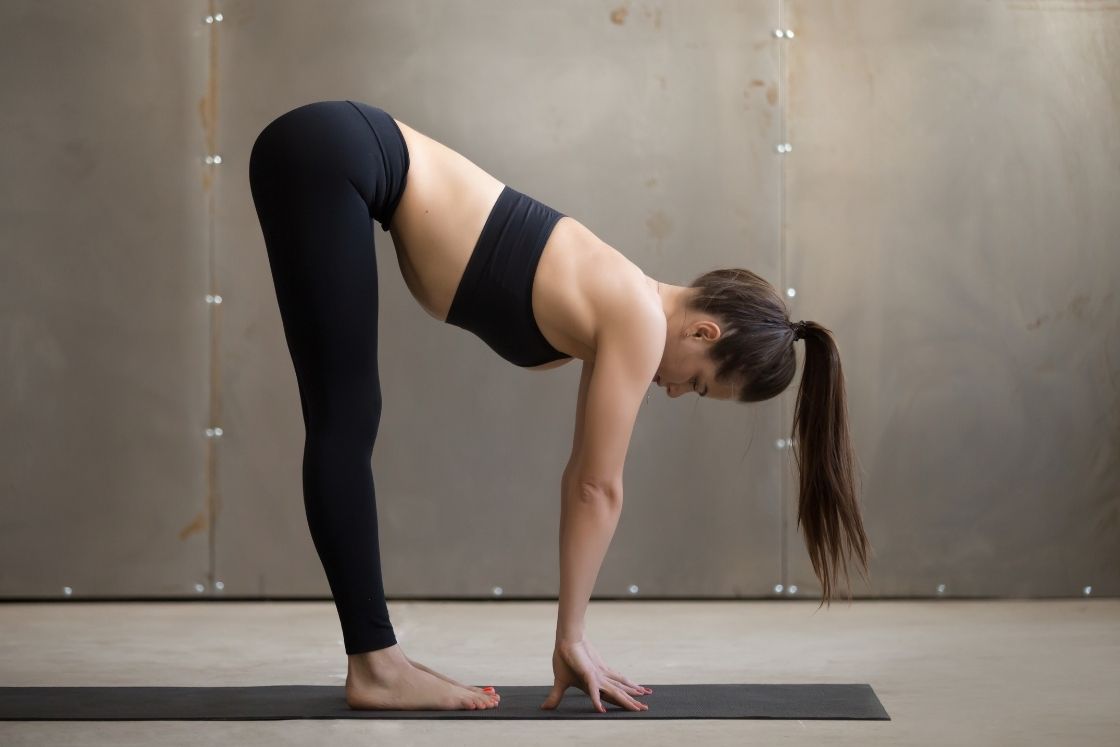
- Uttanasana ragdoll variation – In this variation, the practitioner holds the elbows with alternative hands and the head comes on the arms. Swing a little side-to-side and then stay for a few seconds.
- Uttanasana with hands below the skull – Here, perform the forward bend by keeping the hands at the base of the skull. Try to bring both elbows inwards.
- With arms overhead – After bending forward bring your arms backward and interlace the fingers of both the hands. Now, bring the hands towards the head and try to point the index fingers forward.
- Revolving Uttanasana – This is an advanced version. After reaching the uttanasna try to hold the outer side of the left foot with your right arm. The left hand also holds the foot from another side, it opens the chest to the left. Keep looking forward underneath the left arm.
- Ardha Uttanasana – In this pose, instead of folding completely downwards, you hold the trunk in half -parallel to the floor. It’s a good preparatory pose to open hips for full Uttanasana.
Uttanasana Benefits
1. Relieves stress
Uttanasna increases the level of calmness in individuals hence alleviates the symptoms of stress, anxiety, and fatigue. It relaxes the mind by balancing the nervous system & activating the parasympathetic system. Also, blood circulation and the flow of fresh oxygen to the brain increased on performing this, hence, it relieves stress [efn_note] Yoga as a Remedy for Anxiety and Depression https://ijisrt.com/wp-content/uploads/2018/11/IJISRT18OC375.pdf [/efn_note].
2. Strengthens and stretches lower body muscles
The pose involves stretching of the lower body deeply. It stretches the entire lower body including the hips, hamstring, and calves. It also provides a deep stretch on the spine making it flexible. Therefore Uttanasana enhances endurance and strengthens the hamstrings, knee joints, and ankles.
3. Burns abdominal fat
During the forward bending the abdominal muscles contract to make forward bending possible. This action of forward bend is a great workout to burn the belly fat. It tones the abdominal muscles and cavity. It melts any excess fat from this region by stretching the lower abdomen.
4. Aids digestion
Along with pressurizing the abdominal cavity, it activates the abdominal organs which participate in the digestion process & secret digestive juices. This improves the functioning of the digestive system. It is even evident from a scientific study [efn_note] Effect of Yoga and Music Therapy for Stress Management in Menopausal Women: a comparative Study http://indianyoga.org/wp-content/uploads/2018/03/v7-issue1-article3.pdf [/efn_note] that uttanasana helps in better digestion.
5. Removes stiffness
During uttanasana, the neck is hanged down surrendered to gravity. It helps in releasing any trapped tension and stiffness around the neck, spine, and shoulder.
6. Stimulates kidney, liver, and spleen
Uttanasana looks very simple but its effect on internal organs is very deep. It improves the functioning of the kidney, liver, and spleen. However, it further makes the body’s metabolism and immune system stronger.
7. Cures infertility
There are a lot of cases in which the stress acts as a barrier that prevents the female body from conceiving. Uttansana is found helpful to prevent stress and thereby prepares the body better for conceiving [efn_note] Yoga Can Improve Assisted Reproduction Technology Outcomes in Couples With Infertility https://www.researchgate.net/publication/320958174_Yoga_Can_Improve_Assisted_Reproduction_Technology_Outcomes_in_Couples_With_Infertility [/efn_note].
Besides, the bend involved stimulates the endocrine system and maintains the hormonal balance.
8. Eases the menopause
During menopause, the body experiences a hormonal imbalance. The symptoms create irritation, mood swings, disturbed sleep patterns, etc. Uttanasana eases the symptoms.
Conclusion
Try uttanasana to give your body a deep sense of relaxation and stretch. With providing all the health benefits it makes the practitioner self-aware.
The body undergoes different experiences each time it is practiced. This makes uttanasna a must-to-do yoga pose for beginners as well as advanced yogis.
